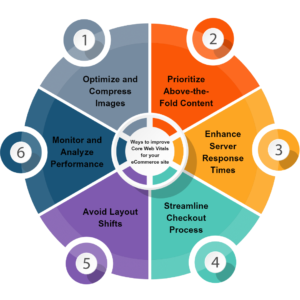The success of an eCommerce site hinges on its ability to provide a smooth and seamless online shopping experience. Customers expect fast-loading pages, responsive designs, and excellent usability. Google’s Core Web Vitals have emerged as crucial performance metrics that directly impact search engine rankings and user satisfaction. In this blog, we will explore effective strategies to optimize Core Web Vitals for eCommerce sites, ensuring enhanced performance and improved customer engagement.
Understanding Core Web Vitals for eCommerce Sites
Core Web Vitals are a set of essential performance metrics introduced by Google to evaluate user experience on the web. They consist of three key factors:
Largest Contentful Paint (LCP):
Measures the loading speed of the main content on a page. For an eCommerce site, it could be the product images or descriptions that need to load quickly to engage visitors.
First Input Delay (FID):
Evaluates the interactivity of a webpage by measuring the time between a user’s first interaction (such as clicking a button) and the browser’s response. FID is crucial for seamless navigation and checkout processes.
Cumulative Layout Shift (CLS):
Assesses visual stability by measuring unexpected layout shifts during page loading. A high CLS score can lead to accidental clicks or frustrating experiences for shoppers.
Practical ways to improve these Core Web Vitals for your eCommerce site.

Optimize and Compress Images
Images play a pivotal role in eCommerce, but they can also contribute to slower page loading times. To enhance LCP, compress and optimize product images without compromising quality. Use modern image formats like WebP, utilize lazy loading techniques to load images as users scroll, and leverage content delivery networks (CDNs) to serve images efficiently from geographically closer servers.
Prioritize Above-the-Fold Content
Ensure that critical above-the-fold content, such as product descriptions and add-to-cart buttons, loads quickly. Lazy loading techniques can help defer non-essential elements, allowing users to engage with essential elements swiftly. Additionally, leverage browser caching and minify CSS and JavaScript files to expedite overall page rendering.
Enhance Server Response Times
Reducing server response times is crucial to improving FID. Optimize server configurations, employ caching mechanisms, and utilize content delivery networks to minimize network latency and enhance user interactivity. Consider upgrading to faster hosting plans or using a reputable hosting provider that specializes in eCommerce websites.
Streamline Checkout Process
A slow or unresponsive checkout process can lead to cart abandonment and dissatisfied customers. Optimize FID by eliminating unnecessary steps and minimizing dependencies on third-party scripts during the checkout flow. Simplify form fields, implement smart autofill options, and optimize JavaScript code to enhance user interactions and reduce latency.
Avoid Layout Shifts
Prevent unexpected layout shifts that may frustrate users and affect CLS scores. Reserve space for ads, images, or dynamic content to maintain stability during page loading. Ensure that dimensions of images and videos are specified in HTML to avoid layout adjustments. Implement smooth transitions and animations using CSS, allowing for graceful loading of dynamic content.
Monitor and Analyze Performance
Regularly monitor and analyze your eCommerce site’s performance using tools like Google PageSpeed Insights, Lighthouse, or GTmetrix. These tools provide actionable insights and recommendations specific to improving Core Web Vitals. Regular performance audits will help you identify bottlenecks, implement necessary optimizations, and stay on top of evolving web performance best practices.
To thrive in the competitive eCommerce landscape, providing an exceptional user experience is paramount. Optimizing Core Web Vitals for your eCommerce site will not only improve your search engine rankings but also enhance user engagement, reduce bounce rates, and boost conversions. By implementing the strategies outlined above, you can ensure a faster, more seamless shopping experience for your customers, ultimately leading to greater success for your online business.
Check out our Previous Blogs- Keep Up With All The Latest In The Digital World







